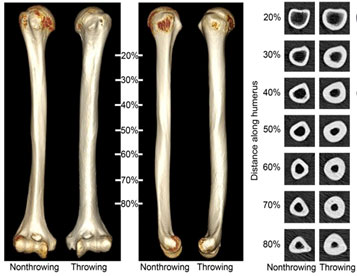I get asked a lot of questions about the effectiveness of vibration platforms. Before I describe what these machines are, let’s take a quick visit to Bone Biology 101.
Why and How Exercise Strengthens Our Bones
Bone adapts to what is demanded of it – this is the fundamental principle behind Wolffe’s Law. If loading on a particular bone increases, such as when we do certain exercises or weight-bearing activities, that bone will remodel itself over time to become stronger. It will adapt to the demands placed on it.
This fact was beautifully demonstrated in a study of professional baseball players who, due their repetitive, one-sided sport, provided a perfect study sample (1). What was found was that the density, size, and strength of the bone in the throwing arm was significantly greater than the non-throwing arm. The picture below, provided by this study, says it all.

So, you may wonder, what does all this have to do with vibration platforms?
The NASA Connection
The premise is that bones can also be strengthened by standing on these platforms. The initial research began decades ago, as NASA searched for a way to mitigate the bone loss that astronauts experienced (1-2%/month) while in space. The technology, once developed for astronauts, was eventually revised for general medical and public use.
What These Platforms Actually Do
In low-intensity vibration therapy, you stand on a platform that looks similar to a large bathroom scale, for 10-20 minutes/day, while it oscillates up and down. The sensation delivered is barely noticeable, and has been compared to the purring of a cat. Both the size and speed of the vibration, about 30 cycles/second, are said to match the natural skeletal stimulation that occurs as your muscles imperceptibly relax and contract to maintain your upright, standing posture.
Do They Work?
The benefits claimed by the two main companies that manufacture low-intensity vibration platforms, (Juvent, Marodyne), include not only improved bone health, but also less joint pain, better range of motion, enhanced strength, better circulation, better lymphatic drainage, and more. But at a cost ranging from $2000 – $5000 (not covered by insurance), do they work?
Unfortunately, while generally very safe to use, the evidence is not yet clear. A 2016 meta-analysis found that out of 358 potentially relevant references, only 9 met their criteria for a methodologically sound study (2). In other words, most of the studies did not meet the standards needed to accurately access the benefits of these platforms. Of the remaining 9, there are some suggestive, hopeful benefits, but it’s still not a slam dunk.
Despite the long list of glowing testimonials on the product websites, which include everything from an improved golf swing to relief of restless leg syndrome, many of the studies they cite claiming positive benefits are not actually related to the specific device they are selling! The vast majority of the studies are about “whole-body” vibration, which I describe below.
Safety Concerns with High-intensity Whole-body Platforms
The machines I have discussed so far are not to be confused with high-intensity, whole-body vibration machines or plates. You can actually see the person being vibrated on this type of platform. They are often found in gyms and are mainly used for exercise training, but are also promoted for bone building. The safety concerns with these include dizziness, headache, vertigo, as well as many more serious complications such as eye injuries. People with joint replacements should not use these, and they are not recommended for people with heart disease, vertebral or disc defects, diabetes, epilepsy, tumors, a propensity for blood clots, or pregnant women. Since they are promoted as exercise equipment, they are not subject to FDA review.
The Bottom Line
I plan to keep following the research in this area, and hope for better outcomes. For now, I cannot, in good faith, recommend these devices.
- Warden SJ, et al. Physical Activity When Young Provides Lifelong Benefits to Cortical Bone Size and Strength in Men. Proceedings of the National Academy of Sciences April 2014; 111 (14):5337–5342.
2. Fratini A, et al. Whole Body Vibration Treatments in Postmenopausal Women Can Improve Bone Mineral Density: Results of a Stimulus Focussed Meta-Analysis. PLoS ONE 2016;11(12): e0166774.
